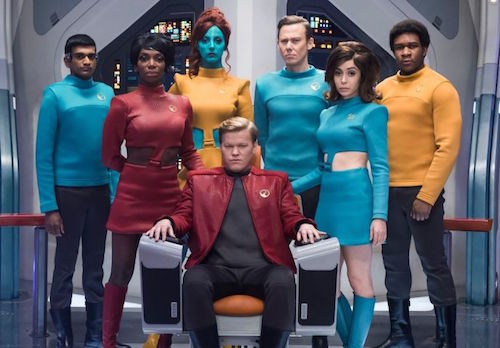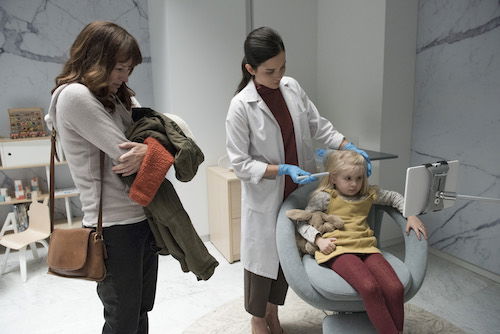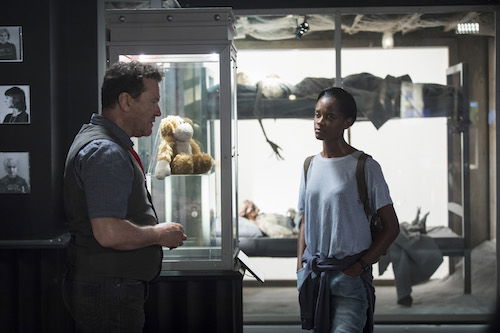Another year, another six episodes of dark stories of technology and the loss of humanity that results. This time around, we (that is to say Sara and Andrew) have worked together to give you our take on Black Mirror Season 4, episode by episode, to give you the full look at season with all its finer points and faults. But that, of course, means plenty of spoilers below, so be forewarned if you haven’t watched the season yet.

USS Callister
The “USS Callister” was the episode I was most looking forward to, given what a huge Trekkie I am. However, I had no idea what the plot was going to be. Once, however, the whole package started to devolved, I actually liked it even more. Robert Daly works as a CTO for “Infinity” an online gaming system that takes players into the game. However, feeling disrespected at work, he has a habit of taking people’s DNA and using it to re-create them in a virtual world modeled after “Space Fleet” (a rip-off of Star Trek). The trick is, however, that when he creates them in the game, they have the same personalities and memories as their living counterpoints up to the point of the virtual creation. Whenever one of them disrespects Daly in the real world, he goes home at night to torture their copies. Enter Nanette Cole, a new coder at the copy who catches Robert’s eye. When she gets into the game, however, she leads a plan against him, getting real-life Nanette involved as well.
This is, again, one of the new Black Mirror episodes that has a happy ending. I will say that it doesn’t feel as earned, only because we don’t see the passage of time and what these copies have to endure. Without that passage of time, it feels like Nanette just sweeps in and saves everyone within 48 hours. There’s little build up to real-life Nanette stealing the DNA samples, and there is no showing of any fallout from it. After all, once the digital versions are out in open Internet, they could expose everything about Robert Daly and his awful nature. However, it is still a very interesting scenario, even if the science on it is wonky (and no, DNA doesn’t retain your memories).
This episode is jam-packed with stars. Besides the Kirsten Dunst and Aaron Paul making surprise cameos (I know, look for them), we have character actor Jimmi Simpson, Jesse Plemons from Fargo, Cristin Milioti of How I Met Your Mother fame, Michaela Coel from Chewing Gum, and film actor Billy Magnussen. They all give stellar performances that really sell the concept, and make you care about their virtual struggle but also how they work in the real world. The cinematography is excellent and the overall writing is excellent.
Arkangel
How protected should children be? It’s no secret that we live in a pretty messed-up world. Kidnapping, sexual abuse, serial killers, hit and runs, and that’s not counting for the all the terrible shit kids do to each other. So if you could watch over them 24/7, would you? That’s what happened with Marie, a nervous single mom who has her daughter Sara implanted with a special chip that lets her monitor her vitals and where she is. However, when Sara grows up and starts lying to to her, Marie digs out the old Arkangel to spy on her, and ends up seeing some private things she shouldn’t. And if you don’t know how this ends, you haven’t watched enough Black Mirror.
This episode was directed by Jodie Foster, and it definitely gets into those dark emotional places. I think this episode pair especially well with a movie like Lady Bird in its discussion of mother-daughter relationships. At first, you think it’s going to all going to be fine when Marie puts the tablet away for several years, but her resolve fails when Sara gets caught in a lie. The ending is not that shocking, but it somehow feels lacking, like there’s just not enough fall through. Where this episode shines is in the storytelling, with the use of walking to transition time, and showing the good effects as well as the bad. Rosemarie DeWitt plays Marie beautifully, and with such total emotional vulnerability that it’s hard to ignore while Brenna Harding as teenaged Sara and Sarah Abbott as nine-year-old Sara have such an intensity that really makes the character feel whole.
This episode feels very by the numbers for Black Mirror, and there doesn’t end up being any suspense or any shocking twists and turns. But there’s nothing that makes you think either. It is clear that Marie’s overprotectiveness and lack of trust of her daughter is going to ruin everything, none of it feel relatable or strikes any truths in a unique way. It’d be a great episode of any other show, but here, it’s just disappointing.
Crocodile
Of all the episodes of season four, “Crocodile” has the least to do with futuristic technology. This achieves mixed results. There’s a good degree of believability to the episode, which doesn’t hinge so much on one piece of society changing technology as it does on the events surrounding them. The world legitimately feels like the near future, with tech that’s more advanced than that of the present day but not totally mind bending. Self-driving cars are already making their first appearances so it’s not a huge leap that one could also serve as an automated food truck.
Still, with the technology serving as set dressing, the real plot of the episode should be compelling, and it isn’t. “Crocodile” begins with a car accident in which a man and woman fatally hit a cyclist. After dumping the body they move on. Or at least the woman does and manages to find success, but the man doesn’t and wants to come clean. And what’s the best way to cover up a murder? Apparently, with another murder. Which can be covered up with another and another and so on. Basically, it’s Macbeth in the future. But while Macbeth deals with an unquenchable thirst for power, the events of “Crocodile” are propelled by the need for covering up murders with more murders. Alas.
Again, all of the extraneous details are great. In addition to the technology involved, the setting is fantastic. Wide shots of frozen mountains and landscapes convey the bleak situation the characters are in. Juxtaposed with the claustrophobic shots in the city, you can feel their secrets threatening to burst out into the public eye. It’s not enough to fully salvage the episode, but it at least provides a remarkable backdrop to an unimaginative story.
Hang the DJ
Hang the DJ is probably the most innocuous of the episodes, but also the creepiest, when you think about it. Here’s the gist of it – Amy and Frank are going through a system in order to find their perfect match, which requires them to go on a number of dates. Their Coach, the small circular device that acts like an all-knowing Siri/Google, tells them how long these relationships are meant to last. Amy and Frank meet together on their first one and find they are instantly attracted to one another. However, they keep being split up, either by their own insecurities or the system. They decide to run away together and leave the system behind, even if it might mean death. It turns out, though, that their suffering and their sacrifice was just part of a simulation designed to match a real Frank and Amy who are at a party together.
One has to wonder if the team was looking to make another “San Junipero” here, where love ends up conquering all. However, it’s a weird definition of love. If simulations of you would run away together and saying “screw you” to all of society enough times, you’re a match. But that’s not always the kind of partner people want, or need. But how do they have so much information on both of them? And who exactly are they using in the simulation in order to calculate who not to pair them with? It also feels a little anticlimactic to have all this incredible build up to such a stupid pay off as simulations for a dating app. That’s not to say that the episode is bad, however, what with the critique on the drudgery of dating and algorithmic pairing up.
Georgina Campbell and Joe Cole have amazing chemistry, and are best when they are allowed to play off each other. The set up of the world is well done, and the way each of the relationships is portrayed is well-executed, both funny and depressing. But, as with other episodes, the aspect of the technology ruining lives or depleting humanity is totally missing since it is all a simulation, and while it’s a well-told story, none of it ultimately matters and that cheats what would otherwise be an excellent episode.
Metalhead
Get in, get the payload, and get the hell out of there. Ah, the classic heist. “Metalhead” starts with this tried and true formula involving three people driving up to a warehouse to pilfer some sort of desired object for a friend who’s dying. The premise is a familiar one, so it’s easy for the episode to tie in the fact that it takes place in a post-apocalyptic wasteland. Then again, the post-apocalypse is nothing new to modern pop culture, so the meshing of the two genres is easy. And smart. Just as we focus on these people and the job they’re undertaking, we wonder about the big picture of how society came to be like this.
However, it’s best if you don’t think about that last question too much. And in some ways, you don’t have to. The episode isn’t concerned with explaining how this came to be. It allows you to fill in the blanks as events unfold and we get a glimpse into this society. It invites the audience to put two and two together, but unfortunately starts to unravel as it does so. Piecing together how civilization came to an end, it becomes obvious that the characters are only making things worse. Coupled with the final revelation of what they searched for, the events of the entire episode feel like a waste as so much is sacrificed for so little.
So the plot’s not quite as clever as it wants to be, and falls apart towards the end. But it looks great during the whole run. Filmed in black and white, “Metalhead” captures the bleak yet futuristic tone of its world perfectly. Not only lacking color, the episode also has long stretches with no dialogue and few people on screen. While these qualities are usually a hindrance to a show, the episode owns them and utilizes them beautifully to serve the plot.
Black Museum
Capping off season 4 is a quite a hefty episode. Not only does “Black Museum” feature three separate vignettes tied together by an over-arching plot, but it also has numerous references to previous Black Mirror episodes. These easter eggs are a joy to spot and fit neatly into hinting at one possible universe that many of these episodes may take part in. Nish (Letitia Wright) visits a museum documenting various crimes where Rolo Haynes (Douglas Hodge) leads her on a tour and tells her the stories of the artifacts within. It’s well worth mentioning that Wright and Hodge are fantastic in their roles and play off each other nicely as we learn more about their own stories in between tales.
The three flashbacks told to Nish by Haynes involve an implant that allows a doctor to feel the pain of others, the multiple transfers of a dying woman’s consciousness, and the transfer of a death-row prisoner’s consciousness into a hologram. Each story is interesting, but not always the most unique from the others or even from other episodes in the season. By the end of the episode, the theme of transferring human consciousness wears thin. But this is a small gripe.
Ultimately, “Black Museum” successfully weaves its stories together and creates a compelling single narrative. It’s no small feat that it even manages to tie in stories from several previous episodes in a way that is subtle. Black Mirror episodes rarely end with a happy outcome. The finale of this one comes close and is best classified as bittersweet. Nevertheless, it really does go the distance to earn that somewhat happy resolution and caps off the season with a sense of fulfillment.
A strong showing but falls short on the critique
A strong showing but falls short
Black Mirror Season 4 provides a fine continuation of the anthology series, but it does lack a certain punch that made watching the previous series thrilling. So many of these episodes lacked in one facet or another, and despite for some great concepts and strong performances, things tended to fall apart in the follow-through.
-
USS Callister
-
USS Callister
-
Arkangel
-
Crocodile
-
Hang the DJ
-
Metalhead
-
Black Museum








